Magnetic reconnection is a fundamentally important process in space plasmas due to its role in changing magnetic topology and the associated release of energy in the form of heated plasma exhausts. Within these exhausts we often observe complex structure in velocity distribution functions (VDFs) that are the signature of a variety of underlying particle acceleration processes. For example, counter-streaming beams are often seen in ion VDFs, and crescent structure is observed in electron VDFs in the electron diffusion region. Several key questions in magnetic reconnection now require detailed examination of the evolution of VDFs in three dimensions through an entire event. In the case of Magnetospheric Multiscale (MMS), this can be extremely time-consuming given the high time-cadence of the measurements.
To address this problem, here we present a new approach to automating VDF analysis. We propose use of machine learning methods to identify separate features within ion VDFs. We demonstrate that an unsupervised machine learning process based on HDBSCAN clustering can quickly resolve distinct populations of ions in the VDF by applying this to a case study using MMS data at the magnetopause. We demonstrate that this method allows for rapid analysis of VDFs recorded during a reconnection event and reveals new information about how the complexity of the VDF and key properties of its component plasmas vary. We discuss possible future applications of this work, for example in the solar wind, noting that the method does not require any assumption about the shape of the underlying distributions and so in principle can identify more complex structure than combinations of e.g. Maxwellian beams.

 PDF version
PDF version
